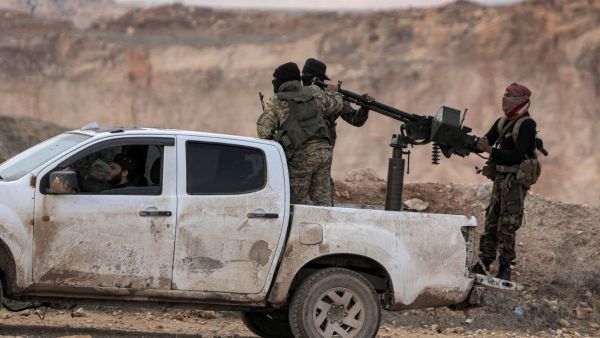ALBAWABA - In contrast to the naïve representations of Syria offered by Western travel bloggers and YouTubers touring regime-held areas, the country has yet to be reacquainted with any real stability.
Indeed, there is a growing possibility that its grinding conflict will worsen in 2023.
Shelling between Syrian Democratic Forces (SDF) and Turkish-back groups, and fighting between rebel groups still plague civilian populations. In districts where Syrian forces have gained control, irregular conflicts persist through violent crime, often by riotous rebels whom the regime has supposedly brought into line.
Biden orders airstrikes against Iranian-backed groups in Syria following attacks near base holding US troops last week - CNN https://t.co/X0RDBvNtip
— AmericanSyrians (@AmericanSyrians) January 15, 2023
A sense of lawlessness fills the South. A menacing mix of armed groups, including former rebels, ISIS fighters, and drug smugglers, are flourishing in the hinterlands. But the most threatening actors are the regime-connected armed forces and militias, whose activities include kidnappings for ransom and the forced abduction of suspected opponents.
Israel and Jordan have looked on anxiously as the presence of Iranian-backed militias, narco-traffickers and Salafi-jihadis has thickened on their borders.
And now with domestic agitation in Iran, and Russian attention drained in Ukraine, the delicate balance of power overseen by the regime’s main patrons is strained.
Consequently, Assad’s control over sizable chunks of territory looks fragile.
It is true that the intensity of Syria’s fighting has decreased, particularly between the regime and the opposition. Although at least 3,825 people died in the conflict in 2022, it represents the lowest yearly toll since the start of the conflict more than a decade ago. This is partly because Russian air strikes have decreased since its invasion of Ukraine.
However, despite this welcome news, the militarism of external powers continues to undercut Syria’s stability and prolong its war.
The threat of escalating conflict between Israel and Iran looms large. This year started ominously with the temporary closure of Syria’s main international airport because of Israeli missiles, which killed two Syrian soldiers.
Israeli operations have multiplied to counter Iran’s growing presence in Syria, which is acting with greater lisence given Russian inattention, and disrupt its increasing use of aerial supply lines to arm allies.
The more immediate threat is a full-scale military operation by Turkey into Syria.
Turkey’s air assaults on Kurdish positions in the northeast have intensified since Nov. 13, when a bombing on Istanbul’s Istiklal Street, a popular shopping area, killed six people and injured 81 others. Ankara alleges that the PKK was responsible.
On Nov. 23, President Erdogan described Turkey’s strikes on Kurdish targets as "just the beginning" of a larger operation, intimating that another full-scale offensive of Syria was forthcoming (as waged in 2018 and 2019).
Facing domestic troubles in the lead-up to the 2023 Turkish presidential and parliamentary elections, it is likely that Erdogan will opt for the attractive distraction of war, eternally used by flagging autocrats.
#Syria#Hasakah
— Levant 24 (@Levant_24_) January 16, 2023
145 Iraqi families were transferred from the SDF-controlled al-Hol camp to a camp in Mosul, Iraq. pic.twitter.com/at2PjWWFHn
ISIS is another threat for Syrian citizens yet to be decisively neutralized.
The caliphate remains a memory, but the Salafi-jihadi organization has evolved into a small but effective insurgency. The number of its attacks is thinning, though their executions have become more sophisticated; in December alone, ISIS craftily breached sensitive military facilities in the northeast, in addition to killing at least 20 people in regime areas.
The upkeep of counterterrorism pressure by the US in the northeast has been an essential factor averting an ISIS resurgence; however, with conflict now swallowing other parts of the world, its longevity is uncertain.
The organization’s potential for recovery largely lies in its thousands of imprisoned fighters, many of whom are haphazardly contained in the al-Hol detention facilities.
A sign of things to come, the SDF said in early December that its joint military operations with the U.S. against the ISIS group have halted due to the threat of Turkish ground offensive and airstrikes, a sign of things to come.
The actual outbreak of war on the Turkish-Syrian border would breed volatility and offer opportunities for ISIS fighters to escape and even regroup.
Equally, the threat of instability is found in the rising poverty of the public.
Syria’s economy has hit its lowest point since the start of its civil war, with spiraling inflation, failing currency, and worsening fuel shortages across the country.
As observed in late December by Geir Pedersen, the U.N. special envoy for Syria, the “needs of the Syrian people have reached the worst levels since the conflict began.”
In early December, two people were killed, including a policeman, when protesters in the southern Syrian city of Sweida stormed a provincial public building in an antigovernment protest.
And in recent days, protests against the regime have emerged in the southern province of Daraa, during which revolutionary songs were reclaimed and pre-Baath Party flags flown high. Modest protests against the regime and its forces began on Dec. 21 and have continued intermittently in at least half a dozen cities and towns across the South.
Syria: Protesters storm governor's office in southern city of Suweida - BBC https://t.co/olKQRTqgxP
— AmericanSyrians (@AmericanSyrians) January 18, 2023
With 2023 forecast to be defined by a humanitarian crisis, localized anti-regime mobilizations will likely multiply and add to the country’s brittleness.
With many sources of present and potential instability in Syria, perceptions about the end of the civil war need revision. It is little wonder that many Syrian refugees are resisting pressure to return home for the time being.










